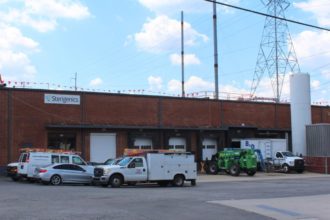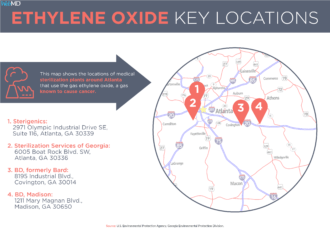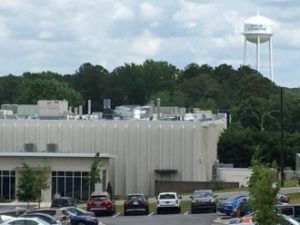Brenda Goodman is a senior news writer for WebMD. Andy Miller is editor and CEO of Georgia Health News.
Story updated
Initial testing of the air near a medical supply sterilizing facility in Smyrna found little to no ethylene oxide in the large majority of samples taken earlier this month.
The September tests occurred days after Sterigenics shut down the plant, which uses ethylene oxide (also known as EtO), a cancer-causing chemical.
The testing company, GHD, told a local oversight committee at a Smyrna meeting Monday that about 80 percent of the samples reported over a three-day period showed non-detectable amounts of ethylene oxide.
The testing, though, did measure significant levels in several canisters placed near the plant recorded on the first day of testing.

“I think it’s pretty damning, actually,” said Richard Peltier, PhD, who studies exposure to environmental chemicals at the University of Massachusetts Amherst.
Peltier reviewed a map of the testing results that was shared at the meeting of the Air-Quality Oversight Committee. The map showed test results in the immediate vicinity of the Sterigenics plant, which sits in unincorporated Cobb County, just north of the Fulton County border.
Of the 75 samples collected, about 60 showed no detectable level of ethylene oxide, meaning the concentration of the chemical in the air was less than 0.040 parts per billion, which is the minimum level that can be detected by laboratory instruments, according to the Marietta Daily Journal.
The EPA reports that 0.02 micrograms per cubic meter is the level of ethylene oxide in the air that over many years could cause 100 additional cases of cancer per 1 million people. This is considered the baseline acceptable exposure level.
On the first day of GHD testing, six sample locations showed much higher levels of ethylene oxide, the most extreme being 4.4 parts per billion or 7.9 micrograms per cubic meter — 395 times the 0.02 threshold. the Daily Journal reported.

The highest level on the first day of testing, at canister 13, diminished on the second day to a non-detectable amount, said Dyron Hamlin of GHD. “On Day 2, that sample was a non-detect,’’ he said.
That high level isn’t necessarily unusual, Hamlin told the Air-Quality Oversight Committee. “This is a very small snapshot of what these levels are.’’
GHD said the results presented Monday were preliminary and not finalized.
The Sterigenics plant shut down Aug. 26 to install improvements in pollution control. The testing will resume in October, after Sterigenics restarts its sterilization operation.
The testing was demanded by local residents and government officials, who have been questioning the safety of the sterilization process since a July report from WebMD and Georgia Health News identified three metro Atlanta census tracts in EPA data as having an elevated cancer risk from air pollution, largely driven by ethylene oxide.

Two of the tracts are in the Smyrna area, just northwest of Atlanta. The third is in Covington, about a half-hour east of Atlanta, where another medical sterilization facility, run by BD, uses ethylene oxide.
The EPA classified the chemical as a cancer-causing substance in 2016.
The medical sterilizing industry and the American Chemistry Council, an industry trade group, have emphasized that there are other ways ethylene oxide can get into the air, including from diesel trucks and other vehicles.
The Smyrna area testing sites are near I-285 northwest of Atlanta. State and federal officials have also pointed to vehicle exhaust as another possible source of the pollution.
But Hamlin of GHD said that based on data from this and other projects, “I can’t say that we see a particular influence from the interstate. But certainly that’s something we’re still keeping an eye on and looking into.’’
“I don’t think there is complete consensus’’ on causes of ethylene oxide in ambient air, he said.
Separately, the state Environmental Protection Division (EPD) on Monday released more results of ethylene oxide testing at its south DeKalb County monitoring site, which is several miles from Sterigenics and BD and near I-285 southeast of Atlanta.
The agency said last month that the first south DeKalb test revealed an ethylene oxide concentration of 0.309 micrograms per cubic meter of air at that site – considered a high amount of the chemical.
But the EPD results released Monday showed much lower levels in tests taken Aug. 13 and Aug. 16. Those results indicate that concentrations of ethylene oxide were below the lab’s detection limit of .0452 micrograms per cubic meter of air, the EPD said.
Members of the group Stop Sterigenics – Georgia said that the testing results around Sterigenics were helpful from a baseline standpoint. But they said an opportunity was missed in not sampling the air before the plant shut down.

“In a perfect world, we’d like to have testing [results] before they shut down,’’ said Tony Adams, who lives near the Sterigenics plant. “We’re never going to get that.’’
When Sterigenics resumes operations, Adams said, “to get a true reading, [the company] needs to be running at 100 percent. It will be hard to verify that.’’
The Air-Quality Oversight Committee includes members of the three local government entities – the City of Smyrna, Cobb County and the City of Atlanta – that are paying for the GHD testing.
But Adams and another member of the group, Emrys Treasure of Atlanta, said the oversight committee had shown no transparency in announcing its meetings.
There was no prior notification to the public of the first committee meeting, held in August, nor the Monday meeting, the Stop Sterigenics members said.
The City of Covington, meanwhile, said it’s likely that independent testing around the BD sterilization plant will begin this week. The city plans to test for seven days, and has hired a different company, Montrose Environmental, to do the sampling.
Jason McCarthy of Say No to EtO – Georgia, which is fighting BD pollution, said Monday that “I believe the plan for testing is about as good as we could hope for. They are using a firm that has no conflicts with BD and has equipment that supposedly can measure EtO at a much lower level than the outfit that Smyrna chose.’’

BD said Monday that it will invest about $8 million to capture fugitive emissions of ethylene oxide at its Covington sterilization facility and one in Madison to the east. “We committed to these additional emission control improvements in writing through a letter to Gov. [Brian] Kemp that was delivered in person on Aug. 20,’’ the company said.
Troy Kirkpatrick, a spokesman for BD, said that “this new system to capture fugitive emissions is a novel approach that requires innovation and new configurations of emission capture technologies. Our sites in Georgia will be among the first in the world to capture fugitive emissions at this level.’’
Sterigenics signed a consent order earlier this month that promised pollution control improvements at its Smyrna plant. BD’s Kirkpatrick said that’s not a legal step that BD plans to make.
“Consent orders are appropriate when there have been regulatory violations or a dispute with the regulator,’’ Kirkpatrick said. “Neither of those conditions apply to BD. We are in full compliance with our permits, operate substantially below our emission allowance within our permits and have voluntarily and transparently committed to make substantial investments in our facilities to even further reduce emissions.’’

